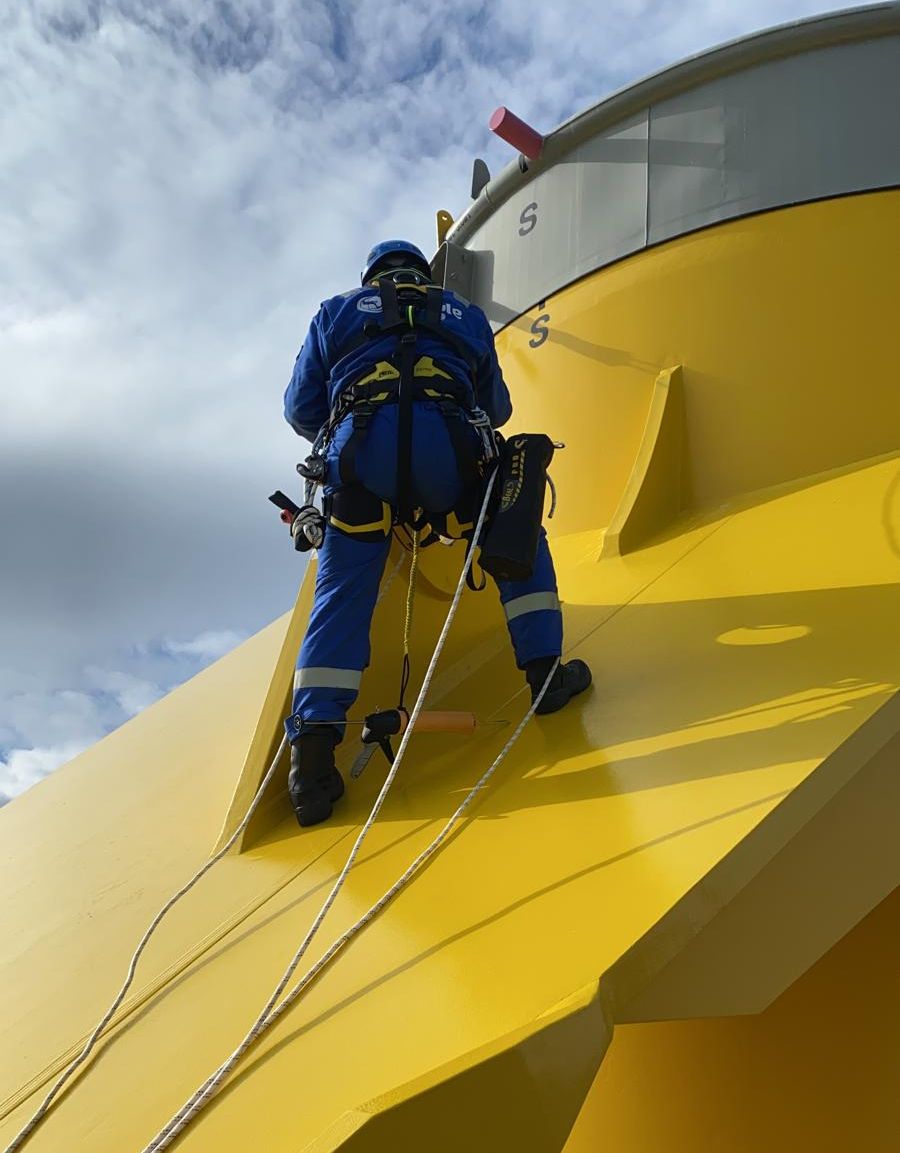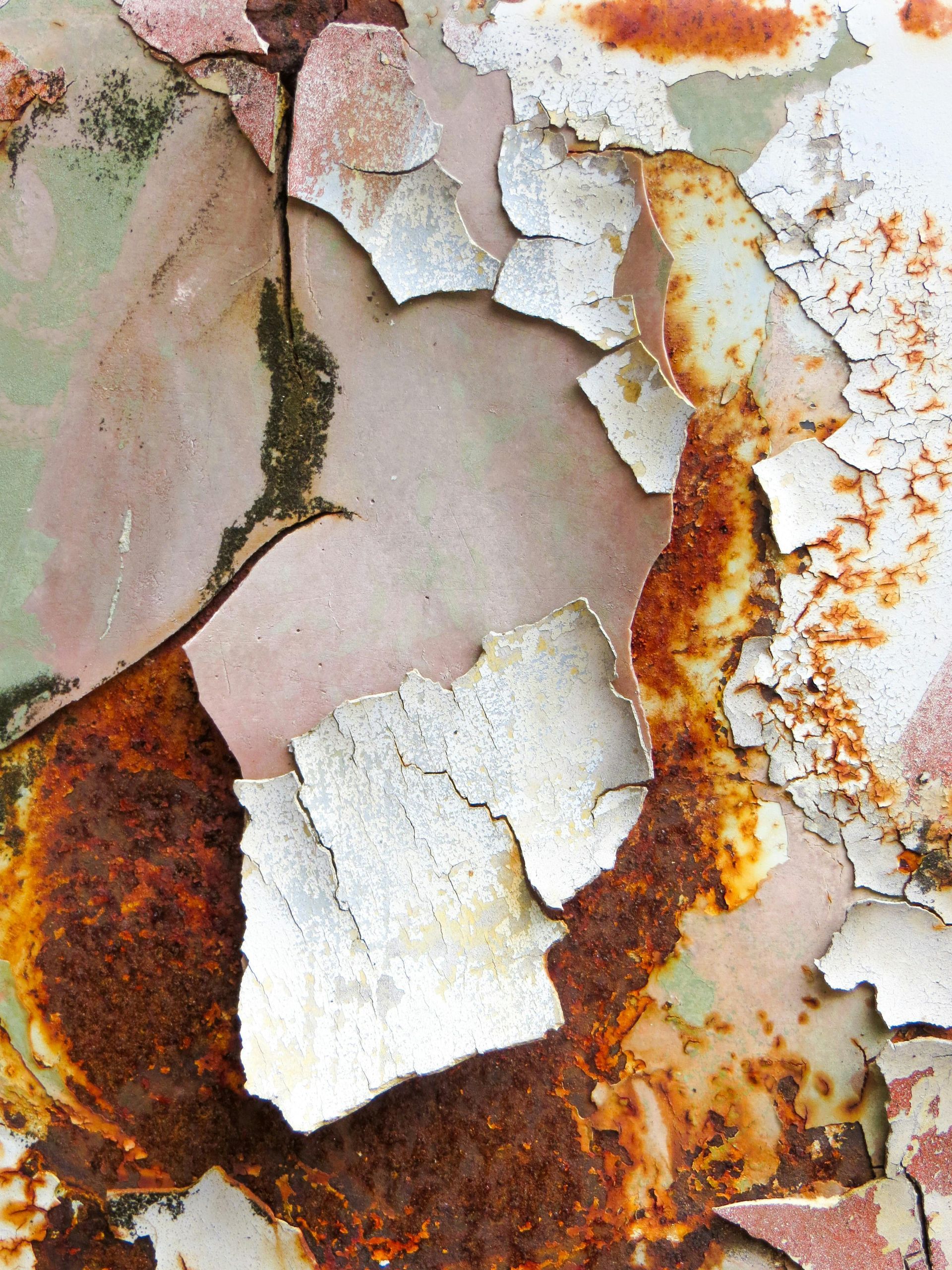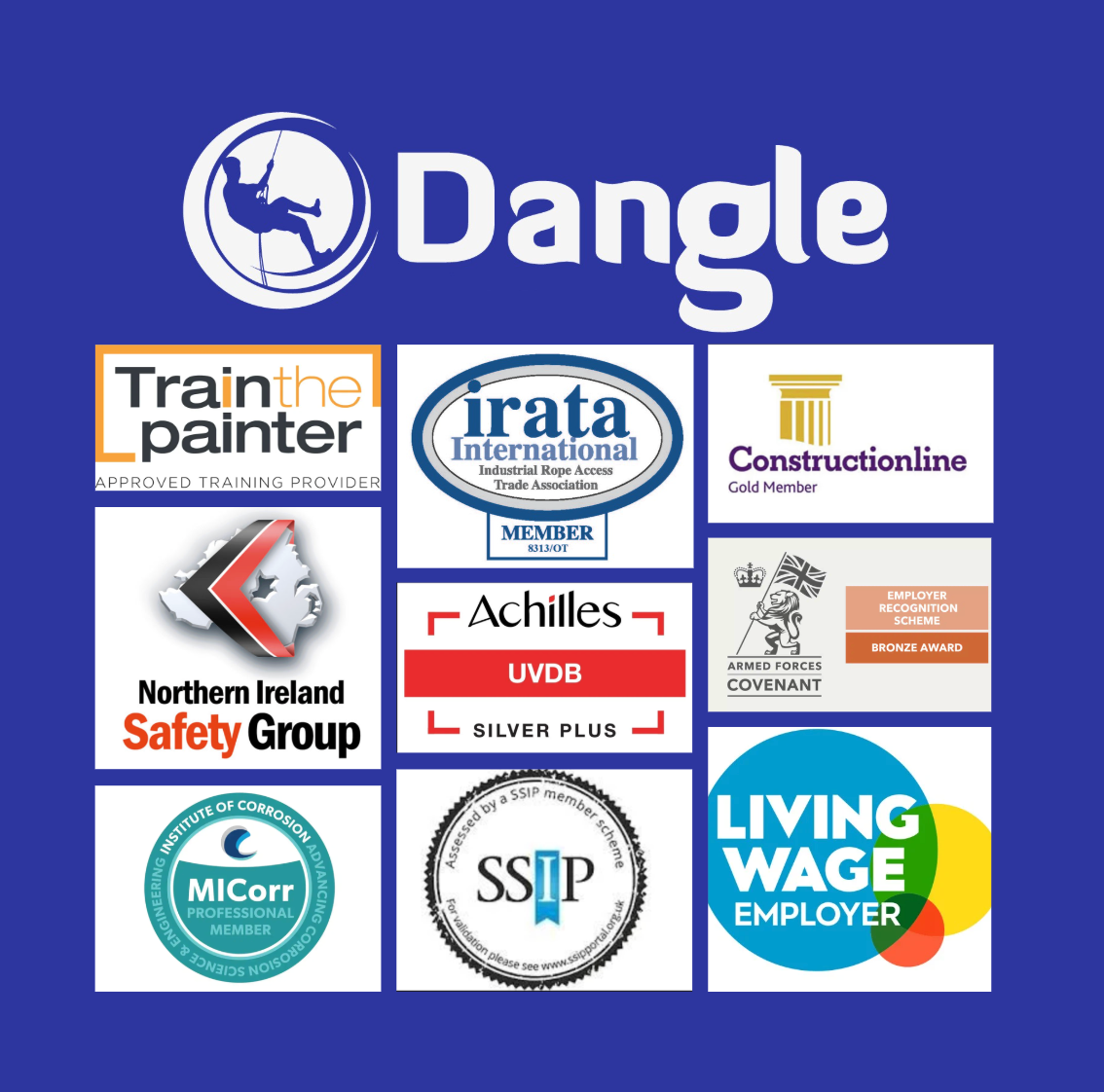Rope Access Painting: Saves Time, Money, and Resources

High Access Painting
Rope Access Painting: Saves Time, Money and Resources
In the world of industrial painting, time is money, and efficiency is everything. That's why more and more companies are turning to rope access painting as a cost-effective solution that delivers exceptional results.
This innovative technique combines the use of specialised rope access equipment and highly skilled rope access technicians to access and paint even the most challenging areas, such as tall buildings, bridges, wind turbine generators and oil rigs. But it's not just about reaching new heights; rope access painting also offers significant time and resource savings compared to traditional methods.
In this article, we will explore the many benefits of access painting using ropes, from its ability to minimise downtime and disruptions to its eco-friendly approach that minimises waste and reduces the need for heavy machinery.
What is rope access painting?
Rope access painting is a specialised technique that involves using ropes and harnesses to access and paint high or difficult-to-reach areas. It is a safe and efficient alternative to traditional methods such as scaffolding or cranes. Highly trained technicians, known as rope access painters, use a combination of climbing and painting skills to execute painting projects with precision and accuracy.
Painting from ropes requires the use of specialised equipment, including ropes, harnesses, carabiners, and descenders. These tools enable painters to safely ascend and descend structures, providing them with the necessary stability and manoeuvrability to complete their work. Additionally, rope access painters are trained in various painting techniques, surface preparation, and the use of different types of paint, ensuring a high-quality finish that meets industry standards.
Rope access painting is not limited to a specific industry. It is widely used in sectors such as construction, infrastructure, offshore, and oil and gas. Whether it's painting the exterior of a skyscraper, maintaining a bridge, or refurbishing an oil rig, a rope access painting company can offer a versatile solution for various painting projects.
Rope access painting
High access painting using ropes offers numerous advantages over traditional painting methods. One of the key benefits is the ability to access and paint difficult-to-reach areas quickly and efficiently.
Unlike scaffolding, which can be time-consuming to set up and dismantle, rope access painting allows technicians to start painting almost immediately after reaching the work area. This minimises downtime and disruptions to other operations, resulting in significant time savings.
Another advantage of rope access coating is the cost savings it offers. Traditional painting methods often require the use of heavy machinery, such as cranes or cherry pickers, which can be expensive to rent and operate. In contrast, rope access painting eliminates the need for such machinery, reducing costs associated with equipment rental and maintenance. Additionally, the efficient nature of rope access painting enables projects to be completed in less time, further reducing labor costs.
Cost savings with rope access painting
The cost savings associated with rope access painting extend beyond equipment and labor expenses. This technique also minimises the need for surface preparation and containment systems, which are often required with traditional painting methods.
With rope access, paint technicians can easily navigate around structures, reaching every nook and cranny without the need for extensive preparation or containment. This not only saves time but also reduces material costs, as less paint and other protective coatings are required.
Furthermore, rope access eliminates the need for scaffolding, which can be a significant expense for large-scale painting projects. By using ropes and harnesses instead of scaffolding, allowing rope access companies like Dangle can avoid the costs associated with renting, erecting, and dismantling scaffolding systems. This cost-saving aspect of rope access painting makes it an attractive option for companies looking to optimise their painting projects without compromising on quality.
Time efficiency of rope access painting
Time is a valuable resource in any industry, and rope access painting offers a time-efficient solution for painting projects. With traditional painting methods, the setup and dismantling of scaffolding alone can take several days or even weeks, depending on the size of the project. In contrast, rope access painting enables technicians to quickly access the work area, eliminating the need for time-consuming preparations.
Additionally, rope access painting allows for simultaneous painting and surface preparation. Technicians can easily move around the structure, preparing surfaces and applying paint simultaneously, resulting in significant time savings. This efficiency is especially beneficial for projects with tight deadlines or those that require minimal disruption to ongoing operations.
Environmental benefits of rope access painting
In addition to its time and cost-saving advantages, rope access painting also offers environmental benefits. Traditional painting methods often require the use of heavy machinery, which consumes energy and contributes to carbon emissions. In contrast, rope access painting eliminates the need for such machinery, reducing its environmental footprint.
Furthermore, rope access painting minimises waste generation. With traditional methods, the use of scaffolding and containment systems often results in significant material waste, including plastic sheeting and other protective coatings. Rope access painting, on the other hand, allows technicians to precisely apply paint without the need for extensive containment. This not only reduces waste but also minimises the impact on the surrounding environment.
By opting for rope access painting, companies can demonstrate their commitment to sustainability and environmental responsibility. This eco-friendly approach aligns with the increasing demand for greener practices in various industries, enhancing a company's reputation and attracting environmentally-conscious clients.
Safety measures in rope access painting
Safety is paramount in any painting project, and rope access painting is no exception. The safety of technicians working at heights is ensured through rigorous training and adherence to strict safety protocols. Rope access painters undergo comprehensive training programs that cover climbing techniques, rope management, rescue procedures, and emergency response.
Additionally, rope access systems are designed with safety in mind. Ropes, harnesses, and other equipment used in rope access painting undergo regular inspections to ensure their integrity. Companies that specialise in rope access painting also have strict safety policies in place, including regular risk assessments, safety briefings, and the use of appropriate personal protective equipment.
By prioritising safety, companies can minimise the risk of accidents and injuries, ensuring a safe working environment for their employees. This commitment to safety not only protects the well-being of technicians but also reduces liability and potential legal issues for the company.
Industries that benefit from rope access painting
Rope access painting is widely applicable across various industries. Some of the sectors that can benefit from this technique include construction, infrastructure, offshore, oil and gas, power generation, and manufacturing. Whether it's painting the exterior of a skyscraper, maintaining offshore structures, or refurbishing industrial facilities, rope access painting offers a reliable and efficient solution.
In the construction industry, rope access painting is often used for high-rise buildings, where traditional methods may be impractical or time-consuming. Rope access painting allows for quick and efficient painting of tall structures, minimising disruptions to ongoing construction activities.
In the offshore and oil and gas industries, rope access painting is essential for maintaining and refurbishing platforms, rigs, and other structures. The ability to access and paint these structures efficiently is crucial for preventing corrosion and ensuring their long-term integrity.
In the power generation sector, rope access painting is commonly used for painting chimneys, cooling towers, and other structures. The time and cost savings associated with rope access painting make it an attractive option for power plants looking to optimise their maintenance operations.
Case studies of successful rope access painting projects
To illustrate the effectiveness of rope access painting, let's consider a few case studies of successful projects:
High-Rise Building Painting
A prominent Belfast city's iconic high-rise building, standing tall and proud amidst the bustling streets, was in dire need of a fresh, vibrant coat of paint to restore its former glory. Its once lustrous exterior had gradually faded over time, leaving the building looking dull and lacklustre. Recognising the urgency of the situation, the building's management sought a solution that would not only revitalise its appearance but also minimise disruptions to its occupants.
Traditional painting methods, which would have involved the cumbersome process of erecting and dismantling scaffolding, were deemed impractical and time-consuming. Weeks of scaffolding setup and removal would have meant prolonged disruptions to the building's occupants, causing inconvenience and hindering their daily routines. The management team needed a more efficient and cost-effective approach that would transform the building's façade without causing unnecessary delays.
Enter rope access painting, a cutting-edge technique that proved to be a game-changer for this ambitious high-rise project. With its ingenious use of ropes and harnesses, this method allowed Dangles skilled painters to scale the towering heights of the building with ease and precision. By eliminating the need for scaffolding, the project was completed in a fraction of the time it would have taken using traditional methods.
The benefits of rope access painting were tenfold. Not only did it save valuable time, but it also significantly reduced costs associated with scaffolding rental. The building's management team rejoiced at the cost savings, as they could now allocate those funds to other pressing matters within the building. Moreover, the absence of scaffolding meant minimal disruptions to the occupants, allowing them to continue their daily lives without unnecessary interruptions.
As our talented painters deftly manoeuvred their way along the building's facade, the transformation was nothing short of remarkable. Day by day, the once-dull exterior began to come alive, as vibrant hues of paint were carefully applied, breathing new life into the structure. Passersby marvelled at the sight, unable to resist stopping in their tracks to admire the building's newfound radiance. The high-rise, once overlooked amidst the city's skyline, now stood as a beacon of renewal and vitality.
In conclusion, the decision to employ rope access painting for the high-rise building proved to be a wise one. This innovative approach not only saved time and costs but also ensured minimal disruptions to the building's occupants. The result was a stunning transformation that revitalised the building's appearance and instilled a sense of pride in all those associated with it.
Offshore Structure Refurbishment
In order to restore our clients' offshore oil rig to its optimal condition, a thorough refurbishment was necessary. This encompassed various tasks, such as painting the structure and implementing corrosion protection measures. If Dangle were to rely on conventional methods, the refurbishment process would have entailed the deployment of cranes and the erection of extensive scaffolding. As a result, the overall expenses would have skyrocketed, and the completion time would have been significantly prolonged.
However, thanks to the implementation of rope access offshore painting, our skilled technicians were able to efficiently execute the project, working directly above water. This method not only minimised the amount of downtime experienced during the refurbishment but also played a pivotal role in reducing the costs associated with heavy machinery and other related expenses. Consequently, our clients were able to witness a successful refurbishment that was both time-effective and cost-efficient.
Choosing a reputable rope access painting company
When considering a rope access painting company for your next project, it is important to choose a reputable organisation that specialises in this access technique. Look for a company like Dangle, with a proven track record in executing successful rope access painting projects. Consider experience, certifications, and safety records to ensure the ability to deliver high-quality results safely and efficiently.
Additionally, ask about the company's training programs and the qualifications of their rope access paint technicians. A reputable company should have highly skilled and IRATA trained rope access technician as well as Train the Painter certified painters who are knowledgeable in industrial painting techniques, surface preparation, and safety procedures.
Furthermore, consider the company's equipment and safety standards. Ensure that they adhere to industry regulations and perform regular inspections of their ropes, harnesses, and other equipment.
Lastly, don't forget to request references and testimonials from previous clients. This will provide valuable insights into the company's professionalism, reliability, and ability to meet project deadlines.
Rope access painting conclusion
Rope access painting offers a cost-effective and efficient solution for industrial painting projects.
With its ability to access difficult-to-reach areas, minimise downtime, and reduce resource consumption, rope access painting is a game-changer in the painting industry. The time and cost savings, along with the environmental benefits, make it an attractive option for companies looking to optimise their painting projects without compromising on quality.
By choosing a reputable rope access painting company and unleashing the power of this working at height technique, you can save time, money, and valuable resources while achieving exceptional results.
Benefit from the versatility and efficiency of rope access painting and take your painting projects to new heights.
Why Choose Dangle's Academy
Here at Dangle, we pride ourselves on offering a wide range of professional and comprehensive inspection, access, coatings, and composite (IACC) industrial services and training courses to cater to the needs of both the private and public sectors. Our dedication to providing high-quality work at height solutions and training has helped us establish a strong reputation in the industry.
With a team of highly skilled and experienced professionals, we are committed to delivering exceptional results that not only meet but exceed our clients' expectations. Our on-site working at height services are designed to minimise maintenance costs in the long and short-term, allowing our clients to save on valuable resources.
Located in Belfast, Northern Ireland, our headquarters serve as the centre of our operations across Ireland. However, we also have a Dangle office based in Scotland, ensuring that we can extend our services to a wider clientele across the United Kingdom. No matter where you are located, our team is always ready to assist you with your industrial maintenance or training needs.
If you would like to learn more about how our dedicated team can help you, we encourage you to get in touch with us today. Our friendly and professional staff are always available to provide you with the information and support you require.
Contact us now to discover the Dangle difference and let us be your trusted partner in meeting your industrial service and training needs today.


